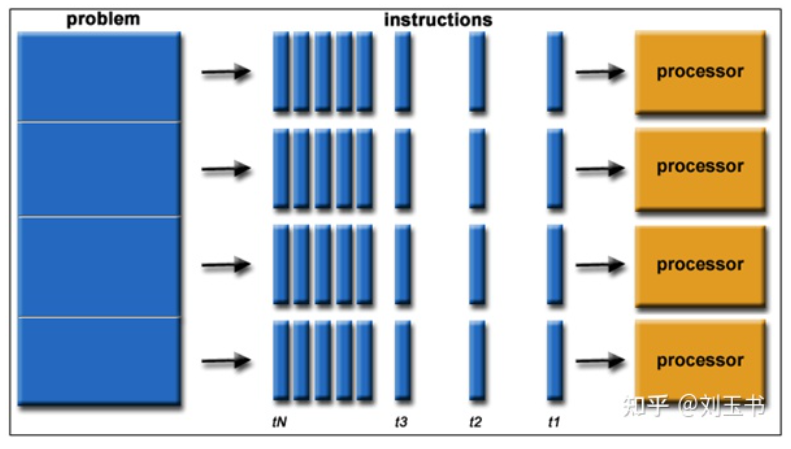20211325 2023-2024-1 《信息安全系统设计与实现(上)》第七周学习笔记
20211325 2023-2024-1 《信息安全系统设计与实现(上)》第七周学习笔记
一、任务要求
1.自学教材第4章,提交学习笔记(10分),评分标准如下 1. 知识点归纳以及自己最有收获的内容,选择至少2个知识点利用chatgpt等工具进行苏格拉底挑战,并提交过程截图,提示过程参考下面内容 (4分) “我在学***X知识点,请你以苏格拉底的方式对我进行提问,一次一个问题” 核心是要求GPT:“请你以苏格拉底的方式对我进行提问” 然后GPT就会给你提问,如果不知道问题的答案,可以反问AI:“你的理解(回答)是什么?” 如果你觉得差不多了,可以先问问GPT:“针对我XXX知识点,我理解了吗?” GPT会给出它的判断,如果你也觉得自己想清楚了,可以最后问GPT:“我的回答结束了,请对我的回答进行评价总结”,让它帮你总结一下。
2. 问题与解决思路,遇到问题最先使用chatgpt等AI工具解决,并提供过程截图(3分)
3. 实践过程截图,代码链接(2分)
4. 其他(知识的结构化,知识的完整性等,提交markdown文档,使用openeuler系统等)(1分)
二、教材知识总结
第四章 并发编程
学习目标
学习了解并发编程的概念,理解并行计算的概念和重要性;掌握线程的原理和其对于进程的优势。通过学习Pthread线程操作,了解如何使用线程进行并发编程;理解死锁问题;通过编程实践更加深入的理解多任务处理、线程同步和并发编程的原理及方法。
并行计算与并行编程
- 并行计算是一种计算体系结构,其中多个处理器同时执行从一个较大的复杂问题中分解出来的多个、较小的计算任务。近年来并行计算已成为计算机体系结构中的主要范例,主要以多核处理器的形式出现。

并行编程
“在并行机提供的并行编程环境上,具体实现并行算法,编制并行程序,并运行该程序,从而达到并行求解应用问题的目的。”
并行与并发
- 并行算法只识别可执行的任务,并行算法中的所有任务都应该同时实时执行。
- 并发性是通过多任务处理实现的。
线程
线程是某进程同一地址空间上的独立执行单元。
创建某个进程就是在一个唯一地址空间创建一个线程。当某进程开始时,就会执行该进程的主线程。如果只有一个主线程,那么进程和线程实 际上并没有区别。但是, 主线程可能会创建其他线程。 每个线程又可以创建更多的线程等。 某进程的所有线程都在该进程的相同地址空间中执行, 但每个线程都是一个独立的执行单元。
实现线程主要有三种方式:
(1)使用内核线程实现
(2)使用用户线程实现
(3)使用用户线程加轻量级进程混合实现
线程的优点
线程创建和切换速度更快
若要在某个进程中创建线程,操作系统不必为新的线程分配内存和创建页表,因为线程与进程共用同一个地址空间。所以,创建线程比创建进程更快。
线程的响应速度更快
一个进程只有一个执行路径。当某个进程被挂起时,帮个进程都将停止执行。相反,当某个线程被挂起时,同一进程中的其他线程可以继续执行。
线程更适合井行计算
并行计算的目标是使用多个执行路径更快地解决间题。基于分治原则(如二叉树查找和快速排序等)的算法经常表现出高度的并行性,可通过使用并行或并发执行来提高计算速度。
线程的缺点
- 由于地址空间共享,线程需要来自用户的明确同步
- 许多库函数可能对线程不安全,例如strtok();
- 在单CPU系统上,使用线程解决间题实际上要比使用顺序程序慢,这是由在运行时创建线程和切换上下文的系统开销造成的。
进程和线程对比
- 一个程序至少有一个进程,一个进程至少有一个线程。
- 线程的划分尺度小于进程(资源比进程少),使得多线程程序的并发性高。
- 进程在执行过程中拥有独立的内存单元,而多个线程共享内存,从而极大地提高了程序的运行效率 线线程不能够独立执行,必须依存在进程中。
- 可以将进程理解为工厂中的一条流水线,而其中的线程就是这个流水线上的工人。
线程操作
线程的执行轨迹与进程类似。 线程可在内核模式或用户模式下执行。 在用户模式下,线程在进程的相同地址空间中执行,但每个线程都有自己的执行堆栈。 线程是独立的执行单元,可根据操作系统内核的调度策略,对内核进行系统调用,变为桂起激活以继续执行等。
Pthread库提供的线程管理API
Pthread库提供了用于线程管理的以下APT。
pthread_create(thread, attr, function, arg): create thread
pthread_exit(status):terminate thread
pthread_cancel(thread) : cancel thread
pthread_attr_init(attr) : initialize thread attributes
pthread_attr_destroy(attr): destroy thread attribute
使用pthread_ create()函数创建线程。
int pthread_create (pthread_t pthread_id,pthread_attr_t•attr,void * (func) (void *), void *arg);
如果成功则返回0,如果失败则返回错误代码。
- pthread_id是指向pthread_t类型变员的指针。
它会被操作系统内核分配的唯一线程ID填充。
在POSIX中,pthread_t是一种不透明的类型。
线程可通过pthread_self()函数获得自己的ID。在Linux中,pthread_t类型被定义为无符号长整型,因此线程ID可以打印为%lu。
- attr是指向另一种不透明数据类型的指针,它指定线程属性。
- func是要执行的新线程函数的人口地址。
- arg是指向线程函数参数的指针
可写为void *func(void *arg)
attr参数使用: 定义一个pthread展性变址pt:hread_attr_tattr。 用pthread_attr_init(&attr)初始化屈性变掀。 设置属性变垃并在pthread_ create()调用中使用。 必要时,通过pthread_attr_destroy(&attr)释放attr资源。
线程ID
线程ID是一种不透明的数据类型,取决于实现悄况。因此,不应该直接比较线程ID。如果需要,可以使用pthread_ equal()函数对它们进行比较。
int pthread_equal (pthread_t tl, pthread_t t2);
线程终止
线程函数结束后,线程即终止。或者,线程可以调用函数以下函数来进行显示终止。
int pthraad_axit {void *status)
线程连接
一个线程可以等待另一个线程的终止, 通过:
int pthread_join (pthread_t thread, void **status__ptr);
终止线程的退出状态以status_ptr返回。
简单编程:利用线程计算矩阵的和
#include <stdio.h> #include <stdlib.h> #include <pthread.h> #define N 4 int A[N][N],sum[N]; void *func(void *arg) { int j,row ; pthread_t tid = pthread_self(); row = (int)arg; printf("Thread %d [%lu] computes sum of row %d\n",row,tid,row); for(j=0;j<N; j++) sum[row] += A[row][j]; printf("Thread %d [%lu] done:sum [%d] =%d\n",row,tid,row,sum[row]); pthread_exit ((void*)0); } int main(int argc, char *argv[]) { pthread_t thread[N]; int i,j,r,total = 0; void *status; printf("Main: initialize A matrix\n"); for(i=0; i<N;i++){ sum[i] = 0; for(j=0;j<N;j++){ A[i][j]=i*N+j+1; printf("%4d ",A[i][j]); } printf( "\n" ); } printf ("Main: create %d threads\n",N); for(i=0;i<N;i++) { pthread_create(&thread[i],NULL,func,(void *)i); } printf("Main: try to join with thread\n"); for(i=0; i<N; i++) { pthread_join(thread[i],&status); printf("Main: joined with %d [%lu]: status=%d\n",i,thread[i], (int)status); } printf("Main: compute and print total sum:"); for(i=0;i<N;i++) total += sum[i]; printf ("tatal = %d\n",total ); pthread_exit(NULL); }
(运行指令须加-pthread)

简单编程:用线程快速排序
#include <stdio.h> #include <stdlib.h> #include <pthread.h> typedef struct{ int upperbound; int lowerbound; }PARM; #define N 10 int a[N]={5,1,6,4,7,2,9,8,0,3};// unsorted data int print(){//print current a[] contents int i; printf("["); for(i=0;i<N;i++) printf("%d ",a[i]); printf("]\n"); } void *Qsort(void *aptr){ PARM *ap, aleft, aright; int pivot, pivotIndex,left, right,temp; int upperbound,lowerbound; pthread_t me,leftThread,rightThread; me = pthread_self(); ap =(PARM *)aptr; upperbound = ap->upperbound; lowerbound = ap->lowerbound; pivot = a[upperbound];//pick low pivot value left = lowerbound - 1;//scan index from left side right = upperbound;//scan index from right side if(lowerbound >= upperbound) pthread_exit (NULL); while(left < right){//partition loop do{left++;} while (a[left] < pivot); do{right--;}while(a[right]>pivot); if (left < right ) { temp = a[left];a[left]=a[right];a[right] = temp; } } print(); pivotIndex = left;//put pivot back temp = a[pivotIndex] ; a[pivotIndex] = pivot; a[upperbound] = temp; //start the "recursive threads" aleft.upperbound = pivotIndex - 1; aleft.lowerbound = lowerbound; aright.upperbound = upperbound; aright.lowerbound = pivotIndex + 1; printf("%lu: create left and right threadsln", me) ; pthread_create(&leftThread,NULL,Qsort,(void * )&aleft); pthread_create(&rightThread,NULL,Qsort,(void *)&aright); //wait for left and right threads to finish pthread_join(leftThread,NULL); pthread_join(rightThread, NULL); printf("%lu: joined with left & right threads\n",me); } int main(int argc, char *argv[]){ PARM arg; int i, *array; pthread_t me,thread; me = pthread_self( ); printf("main %lu: unsorted array = ", me); print( ) ; arg.upperbound = N-1; arg. lowerbound = 0 ; printf("main %lu create a thread to do QS\n" , me); pthread_create(&thread,NULL,Qsort,(void * ) &arg);//wait for Qs thread to finish pthread_join(thread,NULL); printf ("main %lu sorted array = ", me); print () ; }

线程同步
当多个线程试图修改同一共享变量或数据结构时,如果修改结果取决于线程的执行顺序,则称之为竞态条件
在并发程序中,绝不能有竞态条件。否则,觉果可能不一致。
并发执行的线程通常需要相互协作,防止出现竞态条件,线程需要同步。
互斥量
在 Pthread中,锁被称为互斥量,意思是相互排斥。互斥变呈是用 ptbread_mutex_t 类型声明的在使,用之前必须对它们进行初始化。有两种方法可以初始化互斥址。
静态方法:pthreaa—mutex_t m = PTHREAD_MUTEX_INITIALIZER;
定义互斥量 m, 并使用默认属性对其进行初始化。
动态方法,使用 pthread_ mutex _init()函数
- 线程通过互斥量来保护共享数据对象
线程同步的几种方式:
- 互斥锁(mutex)
- 条件变量(condition)
- 读写锁(reader-writer lock)
- 信号量(semphore)
简单编程:Pthread互斥量
#include <stdio.h> #include <stdlib.h> #include <pthread.h> #define N 4 int A[N][N], sum[N]; int total = 0; pthread_mutex_t *m; void *func(void *arg) { int i,row,sum =0 ; pthread_t tid = pthread_self(); row = (int)arg; printf("Thread %d [%lu] computes sum of row %d\n",row,tid,row); for(i=0;i<N; i++) sum += A[row][i]; printf("Thread %d [%lu] update total with %d : ",row,tid,sum); pthread_mutex_lock(m); total += sum; pthread_mutex_unlock(m); printf("total = %d\n",total); } int main(int argc, char *argv[]) { pthread_t thread[N]; int i,j,r; void *status; printf("Main: initialize A matrix\n"); for(i=0; i<N;i++){ sum[i] = 0; for(j=0;j<N;j++){ A[i][j]=i*N+j+1; printf("%4d ",A[i][j]); } printf( "\n" ); m = (pthread_mutex_t *)malloc(sizeof(pthread_mutex_t)); pthread_mutex_init(m,NULL); printf ("Main: create %d threads\n",N); for(i=0;i<N;i++) { pthread_create(&thread[i],NULL,func,(void *)i); } printf("Main: try to join with thread\n"); for(i=0; i<N; i++) { pthread_join(thread[i],&status); printf("Main: joined with %d [%lu]: status=%d\n",i,thread[i], (int)status); } printf ("Main:tatal = %d\n",total ); pthread_mutex_destroy(m); pthread_exit(NULL); }
}

条件变量
条件变量:作为锁,互斥量仅用于确保线程只能互斥地访间临界区中的共享数据对象。在Pthread中,使用类型pthread_cond_t来声明条件变拉,而且必须 在使用前进行初始化。与互斥变量一样,条件变量也可以通过两种方法进行初始化。
静态方法:pthread_cond_t con= PTHREAD_COND_INITIALIZER;
定义一个条件变量con,并使用默认属性对其进行初始化。
动态方法:使用pthread_cond_init()函数,可通过attr参数设置条件变量。
死锁预防
死锁是一种状态,在这种状态下,许多执行实体相互等待,因此都无法继续下去。
防止死锁的发生只需破坏死锁产生的四个必要条件之一即可。
- 破坏互斥条件
- 破坏不剥夺条件
- 破坏请求和保持条件
- 破坏循环等待条件
生产者-消费者问题
该问题需要注意的几点:
- 在缓冲区为空时,消费者不能再进行消费
- 在缓冲区为满时,生产者不能再进行生产
- 在一个线程进行生产或消费时,其余线程不能再进行生产或消费等操作,即保持线程间的同步
- 注意条件变量与互斥锁的顺序

由于前两点原因,因此需要保持线程间的同步,即一个线程消费(或生产)完,其他线程才能进行竞争CPU,获得消费(或生产)的机会。对于这一点,可以使用条件变量进行线程间的同步:生产者线程在product之前,需要wait直至获取自己所需的信号量之后,才会进行product的操作;同样,对于消费者线程,在consume之前需要wait直到没有线程在访问共享区(缓冲区),再进行consume的操作,之后再解锁并唤醒其他可用阻塞线程。
在访问共享区资源时,为避免多个线程同时访问资源造成混乱,需要对共享资源加锁,从而保证某一时刻只有一个线程在访问共享资源。
简单编程:生产者-消费者
#include <stdio.h> #include <stdlib.h> #include <pthread.h> #define NBUF 5 #define N 10 int buf [NBUF]; int head, tail; int data; pthread_mutex_t mutex; pthread_cond_t empty,full; int init(){ head = tail = data = 0; pthread_mutex_init(&mutex,NULL); pthread_cond_init(&full,NULL); pthread_cond_init(&empty,NULL); } void *producer (){ int i; pthread_t me = pthread_self() ; for (i=0; i<N; i++){ pthread_mutex_lock(&mutex); if(data == NBUF) { printf("producer %lu: all bufs FULL: wait\n",me); pthread_cond_wait(&empty, &mutex); } buf[head++] = i+1; head %=NBUF; data++; printf("producer %lu: data=%d value=%d\n",me,data,i+1); pthread_mutex_unlock(&mutex); pthread_cond_signal(&full); } printf("producer %lu: exit \n",me); } void *consumer(){ int i, c; pthread_t me = pthread_self(); for(i=0;i<N;i++){ pthread_mutex_lock(&mutex); if(data == 0){ printf ("consumer %lu: all bufs EMPTY : wait\n",me); pthread_cond_wait(&full,&mutex); } c=buf[tail++]; tail%=NBUF; data--; printf("consumer %lu: value=%d\n",me,c); pthread_mutex_unlock(&mutex); pthread_cond_signal(&empty); } printf("consumer %lu: exit\n",me); } int main(){ pthread_t pro, con; init(); printf("main: create producer and consumer threads \n"); pthread_create(&pro,NULL, producer,NULL); pthread_create (&con,NULL,consumer,NULL); printf("main: join with threads\n"); pthread_join(pro,NULL); pthread_join(con,NULL); printf("main: exit\n"); }

三、课堂代码实现










四、苏格拉底挑战
(1)线程管理函数





(2)线程同步













